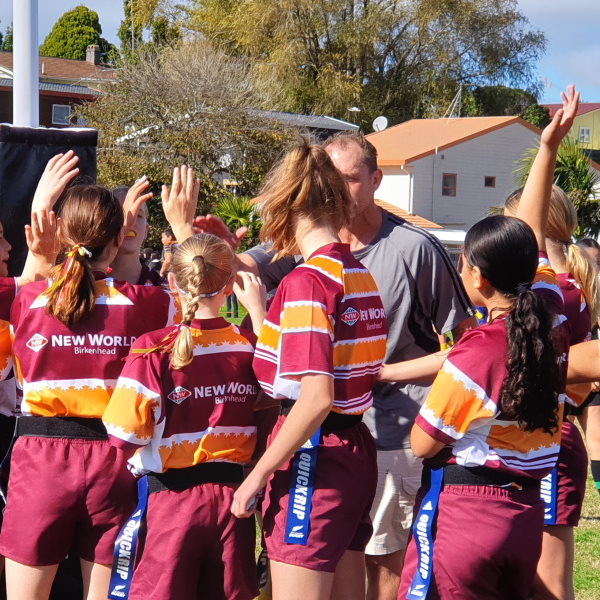
GRADES
U13-15
U13-15
U13-15 Laws
At U13 it's time to really play by the rules. Come U15 the girls themselves know the rules and expect them to be enforced.
- Categoryrules
- Last UpdatedSep 2021
Rippa Rugby is the non-contact version of rugby. It is designed to introduce new players to the game without fear of contact so they can learn the fundamental rugby skills of catching, passing, running, and scoring tries.
Laws
- Field:
- Half-field. 50m wide – goal line to half-way line (sidelines are try-lines)
- Kick-off:
- Punt kick
- Time:
- 25-minute halves and 5-minute half-time
- Kick-off:
- Tap and pass
- Time:
- 25-minute halves and 5-minute half-time.
- Ball:
- Size 5 for Y15/Size 4 for U13
- Players:
- Teams comprise of 7 players. Recommend 10 players per team.
- Subs:
- All players must play half a game which may consist of one half or two quarters i.e. Substitutions may be made at quarter-time, half-time or three-quarter-time. No rolling substitutions are permitted.
- Referees:
- Associate referee, if not - no game
- Tackle (Rip)
- To complete a 'rip' one of the two flags from the ball carriers’ belt must be removed.
- Only the ball carrier can be ripped.
- The ripper stops and holds the flag above their head and shouts "RIP!”
- The ball carrier must then pass the ball within three steps. He or she does not have to stop, return to the mark, or tap the ball before passing
- After the ball carrier has passed the ball the ripper must hand the flag back to the player who then reattaches it to their belt before they rejoin play.
- Four rips in a row lead to a turnover in possession.
- The belt must be worn outside the clothing and flags positioned one on each hip.
- If a player is 'ripped' when crossing the try line, they restart play five metres out from the try line.
- Offside:
- Offside only occurs at the rip.
- When a rip is made, all players from the ripper's team must get back until they are in front of where ball is being passed from (facing the opposition).
- If a player is offside and intercepts, prevent, or slow down a pass, a free pass will be awarded to the non-offending team.
- A free pass is used to:
- Start play.
- Restart after a try is scored (non-scoring team).
- Restart after a turnover or a penalty offence.
- To make a free pass, the referee calls "Play" and the player passes the ball backwards to a member of their own team.
The opposition team must remain five metres back from the free pass.
- Penalties:
- Contact of any kind (pushing, tackling, fending).
- Hiding or shielding Rippa tags.
- Offside
- Diving on the ball on the ground.
- Not handing back Rippa tag.
- Continuing to run after rip (more than 3 steps).
- Turnover of Possession :
- Four rips - Restart with a pass.
- Knock On - restart with a scrum.
- Forward Pass - restart with a scrum.
- Ball or ball carrier outside the field of play. Restart with a lineout.
- Scrums:
- 3 players and a halfback
- No contesting or pushing
- Opposition back lines and those not involved in the scrum must be back 5m.
- The halfback must start and stay at the tunnel of the scrum until the ball has been cleared.
- Players in scrum cannot pick up the ball.
- Attacking team win's own ball
- 3 players in the lineout – the player throwing the ball in then runs around to receive the ball and distributes to the backs
- Lineout must be 2.5m in from touch
- Lineouts are contested
- No lifting in the lineout for U13 while lifting is permitted for U15
- Those players not involved in the lineout must be 5m back.
- 1m gap in between lines
- No player can cross the line of touch (LOT) until the ball is in the halfback’s hands
- A punt kick is used to start the game and restart once a try has been scored (kick must travel 5m)
- The team that scored the try must kick-off
- If you are ripped, you cannot kick the ball
- If a kick in general play crosses the dead ball line it is a free pass at the mark of where the kick was made
- Normal offsides from kicking situations apply
- Kick chasers must stay behind the kicker or be put on-side by the kicker
- There is no conversions or shots at goal
“Everyone Enjoying Rugby”
North Harbour Rugby
Advice & Guidance
Keeping an eye on players being offside is an important thing to watch for. When a rip is made the defenders need to be in front of the ball carrier, not to the side or behind. Standing to the side of the field in line with the offside line can help easily spot when a player is offside and interferes with the play.

